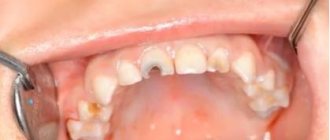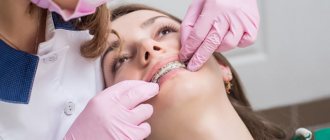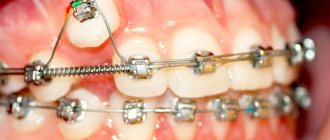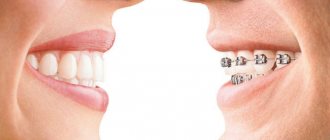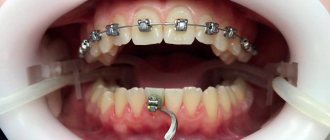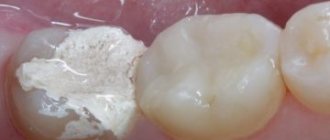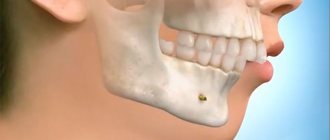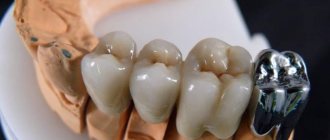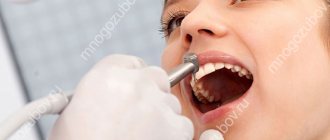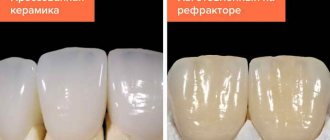Bite problems in children | Self-ligating and ligature systems | Types of self-ligating structures | Material for making braces | Cost of treatment
Parents often ask which braces are best for a teenager, what is the time frame and cost of correcting the bite. The answer to these questions depends on the age of the child and the results of a comprehensive examination: identifying individual characteristics of the development and growth of the facial skeleton, the presence of erupted teeth and tooth germs. During the primary occlusion period, braces are not installed. Orthodontic appliances begin to be worn at the age of 8-9 years: from the moment the upper and lower permanent incisors erupt. For young patients, braces are not fixed on all teeth, but only on four erupted incisors and two permanent molars.
For children from the age of 12, from the moment of eruption of permanent teeth, the structure is installed on all teeth, just like in adult patients. The latter have no age restrictions on orthodontic treatment. The decision of which braces to place on a patient in adulthood depends on the complexity of the clinical case, the characteristics of the profession, aesthetic requirements and budget.
In the period from 12 to 18 years, the development of the dental system is most active. At this age, adolescents are strongly recommended to be monitored by an orthodontist. If it is necessary to correct the bite, treatment will proceed faster than in adults: bone tissue grows, teeth move easier, the forces of the young body are aimed at growth and formation of the facial skeleton. Early correction of a child’s bite allows one to avoid more complex and expensive treatment in adulthood.
teens with Damon Clear braces
Until what age does a person’s jaw grow? The formation of the jaws and facial bones ends by the age of 25. Until this age, the retention period, stabilization of treatment results, will be twice as long as the period of wearing the braces. Thus, when treated with ligature structures (from 2 to 3.5 years), the retention period will be 4 to 7 years. When correcting the bite using devices without ligatures (from 1 to 2.5 years), the retainer is fixed for 2 to 5 years. Patients over 25 years of age wear a retainer indefinitely.
girl with Damon Q
The principle of operation of the braces system
Orthodontic construction, widely used to give teeth the correct position in the jaw, consists of a number of individual elements. First of all, these are clasps that are attached to the enamel surface. They are united into a single system by a force arc - a thick wire that creates the necessary pressure on the teeth.
Braces (clasps), individual elements with special grooves or clips for wires, are necessary to fix the structure on the teeth. Most often they are made of metal, but there may be other options. The clasps are held on the surface of the tooth using a special dental adhesive.
Dental wire is no different in appearance from ordinary metal wire and is gray in color. In expensive orthodontic systems, which are almost invisible on the teeth, white wire may be used. A feature of the arc is “shape memory”. Initially, it has a configuration that corresponds to an ideal bite. When the wire is deformed by the doctor during the installation of the system, it tends to return to its original position, pulls the clasps with it and thus helps correct the position of the teeth.
How to correct malocclusion in children
It is easier to correct an overbite in childhood, but there are many reasons for its development. Thumb sucking, chewing habits, pressing the tongue on the teeth, holding the jaw incorrectly, and others are common. There are several methods to help children in this regard.
Using a pacifier
An orthodontic pacifier is primarily used not to correct the bite, but to ensure that it is formed correctly. Its difference from the usual one is that the shape is as natural as possible, close to the structure of the female nipple. Therefore, sucking it is natural for the baby.
It teaches the baby to hold his jaw and tongue correctly and helps to form correct nasal breathing. As a result, the correct bite is formed, which will help avoid problems in the future.
Using a plate
Plates are removable devices. They can and should be removed periodically to honor them and your teeth. Correction with plates in childhood is achieved quite effectively and quickly. They are intended for:
- holding teeth in the desired position;
- effects on the formation of jaw bones;
- stimulation or restriction of jaw development;
- regulation of the width of the palate.
The disadvantage of records is the age limit. Their use is considered optimal before puberty. As you get older, correcting your bite this way will become more and more difficult. In adults, plates are used only for minor defects.
Using staples
It is recommended to install braces after 8-9 years, the optimal age is 12-14 years. They are indicated for the following disorders:
- irregular shape of the jaw bones;
- too narrow or wide palate;
- abnormal growth of one or both jaws that is too fast or too slow;
- incorrect position of teeth;
- various bite pathologies.
Brackets are similar in design and operation to braces, but are less bulky and removable.
Using trainers
A trainer is a special tire made of elastic material. Their difference from other devices is that the action is not aimed at correcting the bite, but at eliminating the causes that influenced it. When these causes are eliminated, the position of the teeth is normalized.
The trainer helps the facial and chewing muscles work normally, resulting in the formation of a correct bite. The main time of wearing is night sleep. During the day, the device is worn during rest for a maximum of four hours. The device is slow and gentle and cannot correct severe malocclusions.
Features of the children's braces system
Nowadays, orthodontic treatment can be performed on patients of all ages. Dentists actively encourage adults to correct their bite. At the same time, children and adolescents with crooked teeth, for whom the optimal period for correcting dentoalveolar anomalies has arrived, fade into the background. From 12 to 18 years of age, active formation of the jaws occurs, the tissues are flexible, and the teeth respond well to the pressure exerted on them. You can achieve the desired result with the least effort. However, for some reason many adults believe that “the child will outgrow it” and “the teeth will straighten out on their own.”
Up to 12 years of age, during the period of mixed dentition, orthodontic correction can also be carried out. However, the bracket system cannot be used for this purpose, since during this period the pressure of the structure is excessive. It is more advisable to use plates and other orthodontic devices that have a softer and more gentle effect on the dental system.
The age for starting orthodontic correction using a brace system at 12 years is indicated very arbitrarily. The development of children is uneven, so the orthodontist must take into account the individual characteristics of the young patient when determining the indications for starting treatment. The specialist’s decision is based on data from a dental examination and x-ray examination. In fact, the child undergoes the entire range of diagnostic tests that are necessary for an adult patient in the same situation. However, the objectives of the examination differ, just like the algorithms for determining indications and contraindications for treatment.
Children's braces, in addition to a special approach to installation, differ from adults in a shorter wearing period. However, the cost of orthodontic correction in children and adolescents may exceed that in adults.
When should I put braces on my child?
On this issue, the opinions of professional orthodontists differ diametrically: some believe that the earlier treatment is started, the greater the chances of a successful result and the “less bloodshed” you will be able to manage. Of course, there is no talk of any real blood, unless the installation of an orthodontic structure requires cutting the frenulum, but we will have to talk about the inconveniences. Other experts believe that in order to correct both functional and aesthetic problems of the dentition, it is necessary to wait until the permanent bite is fully formed in order, firstly, to avoid relapses, and secondly, to convince the teenager of the need and involve him in conscious work on his health and appearance. The correct answer to the question “At what age do children get braces?” lies somewhere in the middle.
Installation of braces for children from 8 to 10 years old
If we are talking about violations of occlusion, that is, the closure of the dentition, the formation of a deliberately incorrect bite, or problems with teething, then it is really worth starting at a younger age. In childhood, the bones are softer and more mobile, therefore it is much easier to work on them; most likely, even braces will not be needed; an experienced specialist will be able to get by with removable plates and trainers, but parents will need to carry out educational work with the little patient and carefully monitor that he observed the wearing regime. From the age of 6, you can use an alternative system to braces, for example, removable aligners.
When is the best time to get braces for a child over 18 years of age?
As for unevenness, the unfolded position of the teeth in a row, crowding or enlarged teeth and diastemas, here it is really worth waiting for the full formation of the permanent bite and putting on braces; especially disciplined teenagers can, like real adults, undergo treatment with aligners that correct the bite no worse, and sometimes even better, than braces, but requiring strict adherence to the rules and recommendations of the doctor.
Types of children's braces
A fairly large number of modifications of brace systems have been developed and are used, which differ from each other in the location of the structure in the oral cavity and the material from which the clasps are made. Most types of systems can be successfully used in patients of all ages, starting from 12 years of age.
Ways to arrange the structure
Most often in the practice of an orthodontist, vestibular corrective structures are used. Vestibular clasps are attached to the outer surface of the dental crown. Such a device is much easier to install, adjust, and clean from plaque and food debris. Obvious shortcomings include the unaesthetic appearance of the system, which is visible when smiling and during a conversation.
Lingual braces, which are installed on the lingual surface of the teeth, are completely invisible to others and are just as effective as vestibular braces. However, they are made individually from gold and other expensive metals, which determines the high price of the structure. A system for one jaw can cost a patient 120 thousand rubles or more. The system also significantly reduces the oral cavity and limits the movement of the tongue, which affects diction.
For children and adolescents, the aesthetic side of the issue of orthodontic correction is very acute. Any comments or non-verbal signs of disapproval from peers regarding “braces on the teeth” may lead to refusal to continue treatment.
How much will the installation procedure cost?
The average time for bite alignment in children is 1-1.5 years. During this time, he must visit the dentist regularly to have the dentist adjust the position of the braces as the units move. After the child’s teeth have become straight, the orthodontist recommends wearing the appliances for another month to consolidate the results. Some patients have plates placed on the inside of their teeth to prevent them from feeling loose and moving. The cost of braces depends primarily on the material from which they are made. Only after a thorough examination of the child will the orthodontist answer which braces are best for the child and show a photograph of what they will look like. The price of orthodontic treatment is influenced by the degree of neglect of the deviations.
Average prices:
- Metal and plastic structures - 20,000 rubles.
- Braces made of artificial sapphires - 30,000 rubles.
- Ceramic braces - 45,000 rubles.
- Lingual braces or “invisible” braces - 100,000 rubles.
Advantages of installing braces in childhood:
- Regulate the growth of the jaw bones, creating a more favorable environment for emerging permanent teeth.
- Place permanent teeth in the correct position.
- Adjust the width of the jaws.
- Reduces the risk of injury to the front teeth.
- Eliminate bad habits (for example, sucking).
- Reduce the likelihood of teeth getting stuck under the gums.
- Increases space for permanent teeth.
Early dental treatment in childhood can eliminate the need for more radical measures in adult patients.
Ligature and self-ligating systems
Ligatures are additional elements of the bracket system that hold the arch in the groove of the lock. At the initial stage of treatment, pieces of thin wire are used as ligatures. Then they are replaced with elastic bands. The main purpose of the ligatures is to ensure the movement of the clasps following the changing shape of the arch. The wire fixes the braces very tightly, which often leads to uneven load on the teeth. In this regard, aching pain may appear that an adult, let alone a child, can hardly endure. Rubber bands are stained with pigments from food and drinks, which requires their regular replacement.
In self-ligating systems, the clasps have a special clip that secures the arch. The connection using a clip is not as rigid as using a wire ligature. As the teeth shift, the clasps can move within a small range relative to the power arc, which allows the load on the dental system to be distributed more evenly.
It is impossible to say for sure which system is better. Each of them does an excellent job of eliminating dental defects. The duration of treatment does not depend on the type of structure used. The patient will have to visit the dentist to correct the system with approximately the same frequency. Ligature-free systems are made from a variety of materials, which allows you to “play” with shape and color. Ligature rubber bands can be of a variety of colors, which, if desired, allows you to turn an orthodontic structure into a stylish accessory.
Disadvantages of braces for baby teeth
If the issue of physiological influence on the rudiments of teeth is considered and studied, then without discussion it is worth accepting the fact: braces are not the most comfortable orthodontic system. Regardless of what the parents chose – lingual (internal) or conventional, self-ligating braces or ligature – discomfort cannot be avoided.
The first weeks of wearing are associated with a pronounced pain effect, which will be difficult for a small child to endure. Care also deserves special mention. Brushing your teeth while wearing braces is a complex, multi-step procedure. It is difficult for a child to perform all the manipulations.
In addition, the issue of aesthetics, convenience of biting and chewing food and other everyday issues that teenagers and adults can easily tolerate, but young patients cannot, will become acute.
If putting braces on baby teeth is a necessity, you should first discuss all the details with your child. It is better to entrust the dialogue to the doctor as part of preliminary adaptation techniques. The doctor will choose the right words, after which the preschooler will more easily endure the inconvenience of treatment and will agree to wear braces on his baby teeth without whims.
Types of braces depending on material
Metal locks are the most reliable. They are small in size, securely attached to tooth enamel, and are the most durable of all. They are also the most affordable. Their widespread distribution is hindered by the unattractive appearance of the metal structure on the teeth. As a rule, in order to save money, metal braces are often used with ceramic and even sapphire ones, placing colorless elements on the front teeth, and reliable iron ones on large and small molars.
Metal locks are made of titanium, the power arc is made of an alloy of titanium and nickel. It is this combination that gives the product sufficient strength and the ability to withstand significant loads for a long time.
Ceramic braces come in many different shades. The color of the material can be matched to the natural color of the enamel, which will make the locks almost invisible. When producing braces, the greater fragility of dental ceramics compared to metal is taken into account, which is why ceramic clasps are larger than metal ones.
Sapphire braces are made from artificially grown gemstones. They are completely transparent and have a characteristic shine, reminiscent of the shine of jewelry. They are more durable than ceramic and do not change color under the influence of external factors. If you use a white rather than a gray archwire for sapphire clasps, the design becomes almost invisible in the mouth. The only drawback of the sapphire bracket system is its high cost, which significantly “bites” even if some of the clasps that are not visible during a conversation are replaced with metal ones.
Braces made of plastic and silicone
Braces made of plastic and silicone are suitable for those who have a very limited budget for treatment and want to correct minor crooked teeth. An incorrect bite cannot be corrected by wearing plastic structures. In addition, the disadvantages include the sensitivity of plastic to dyes and pigments.
They are made from a plastic composite. It is not difficult to guess that such brace systems are characterized by weak strength. However, the validity period does not imply long-term wearing, so for some this option will be suitable.
Silicone braces are an alternative to regular children's braces for those cases where minor deviations from the norm need to be corrected. Silicone will not injure the mucous membrane.
Psychological preparation of the child
Not every parent can afford orthodontic treatment using sapphire or lingual braces. Yes, this is not always necessary. In addition to the fact that vestibular braces look unsightly, it is necessary to remember that the teeth hurt for the first time after installation, the structure is difficult to clean, and it is even difficult to eat with it. The right attitude helps a teenager cope with discomfort, find ways to turn design flaws into a reason for self-expression (choose colors and color combinations of ligatures, for example).
It is important to respect the child’s opinion and take into account his interests. You should not hush up possible problems associated with everyday wearing of the device, so that later the difficulties do not become an unpleasant surprise for the young patient and cause a decrease in motivation to continue treatment. Carrying out bite correction should be the decision of the child, and not the adults around him, since this is a complex and quite uncomfortable matter.
At the age of 12, not many children think about the need to correct their bite. It is necessary to develop in them an understanding of the importance of the beauty of a smile in interpersonal communication, an understanding of the relationship between the state of the oral cavity and the general state of human health. Well, the most important thing. Even before installing the system, it is necessary to take care of acquiring purely practical skills in caring for the structure. It will be much easier for a young patient to brush his teeth and braces with them if he has already formed the habit of using zuna floss, an irrigator, and mouth rinse.
Parents can teach their child by example by mastering the correct method of brushing teeth and using it regularly. All family members will benefit from this. Also, the time a child wears braces can be used to change the diet of all members. An orthodontic patient cannot eat solid food, so any chips and crackers are prohibited. Sticky and viscous products will take a long time to clean out from the spaces between the enamel and the arc. Changing the diet will allow you to avoid situations where the child feels deprived and switch to eating more healthy foods.
A word to an unhappy child but a happy adult
You can find a lot of interesting stories on forums where adults share their experiences of wearing braces.
“As a child, I wore braces, I was 12 years old and I was terribly embarrassed to smile and laugh, because I had simple “metal” braces. But time passed very quickly. I got used to braces, and my classmates stopped paying attention to them. After the doctor removed them, the teeth became very even and beautiful, even somehow unusual. At first my teeth were very sensitive, but then it went away. Now I am 36 years old, I have a beautiful smile. I am very grateful to my parents for giving me braces when I was a child. Thanks to them, I learned to brush my teeth thoroughly.”
Braces care
In order to clean your teeth and structures from dirt every day, you will have to purchase several special devices at once:
- An orthodontic toothbrush, thanks to its special shape and softer bristles, cleans teeth more thoroughly without the risk of the clasps coming off;
- small brushes, the heads of which are placed between the arch and the surface of the teeth;
- dental floss;
- a special toothpaste and rinse that inhibits the growth of bacteria in the oral cavity after brushing;
- irrigator, a special device that allows you to clean plaque from places where a brush and brushes cannot reach.
The child should be prepared to spend much more time than usual on hygienic cleaning. Especially if before that he did not use a toothbrush every day. The braces system increases the likelihood of developing caries, so you will have to take extra care of your teeth throughout the entire treatment period.
What to do if you notice your child has dental problems?
Installation of a braces system is carried out only if the child has gone through a number of preparatory stages from a specialist doctor.
The main reasons for dental treatment in children:
- Uneven teeth.
- The child's face does not appear symmetrical.
- Impaired pronunciation of words.
- Difficulty chewing food.
Poorly aligned teeth often cause problems in pronouncing sounds correctly. Most disorders are genetic or result from developmental problems.
Some disorders arise from or are greatly aggravated by certain habits and behaviors, such as:
- Breathing through the mouth (for example, with adenoids).
- Thumb sucking.
- Prolonged use of the pacifier.
- Poor oral hygiene.
- Poor nutrition.
For children under 6 years of age, doctors recommend using trainers or elastic mouth guards. This is one of the simplest ways to correct the position of teeth. They are convenient because they are worn only at night, and during the day the mouthguards can be worn for only one hour. In this case, the child experiences minimal discomfort.
Preventive measures when wearing plates:
- Do myogymnastics (develop the muscles that are responsible for the proper development of the oral cavity).
- When teething, do a special massage that corrects their correct growth.
- Grinding of baby teeth (if necessary).
Cost of braces
When discussing the cost of orthodontic treatment, many parents focus only on the price of the braces system. This is one of the most significant expense items, but far from the only one. The average cost of a metal structure per jaw is about 60 thousand rubles. The sapphire system will cost twice as much. It is also necessary to take into account the cost of examination, sanitation of the oral cavity, periodic scheduled examinations to adjust the system, professional oral hygiene procedures once every 3 months. Do not forget about force majeure, when you will have to contact an orthodontist unscheduled. This is a broken arc, unsticking of a lock and other damage that must be removed in a timely manner.
What affects the cost?
The price of a beautiful smile can vary, depending on:
- materials used in the manufacture of braces;
- type of locks and their location;
- clinics (remoteness or proximity to the center, fame);
- level of the attending physician (qualification category, experience).
The material from which the structures are made plays a significant role in the pricing policy; there are the following designs:
- ceramic;
- sapphire;
- metal.
The approximate price of braces depends on the material used:
- metal systems are the most popular and affordable. They are very visible on the teeth; the locks are made of titanium alloy. This is a very effective option. Prices start from 11,000 rubles;
- The ceramic structure is practically invisible, as it can be matched to the same shade as the tooth. For children under 15 years of age, especially boys, they are rarely placed, because such braces are quite vulnerable and fragile. The price can be 18,000 – 70,000 rubles;
- The sapphire system is very convenient. It is distinguished by its reliability and durability, the color matches the tooth enamel. For sapphire braces for children, the cost is slightly higher - from 30,000-100,000 rubles.
If you install a lingual structure (hidden), which is attached to the inside, the price will double. The vestibular one is cheaper, but it is noticeable at the slightest opening of the mouth, especially if the arch is made of metal.
In addition to all the above points, when calculating the amount, the doctor will take into account:
- consultation;
- treatment that was carried out before installing braces, preparation for manipulation;
- the installation of the bracket system itself, the number of procedures;
- manipulations that are carried out after removing the system (restorative procedures).
Each specific situation has its own figure; you cannot rely on rumors and advice given by those who have already installed this structure.
It should be remembered that everything is purely individual – braces, cost, and installation. For children, the price in a clinic that is located in the city center and is popular will be higher than in a less well-known hospital. In the suburbs, the cost decreases due to the distance from the center.
Everything also depends on the specialist who takes on the work. An experienced, qualified craftsman who knows his business will charge a higher price for his services than one who is just starting out.
Before starting the procedure, you need to consult with a doctor, who will describe the essence of the upcoming process and calculate all the financial expenses.
